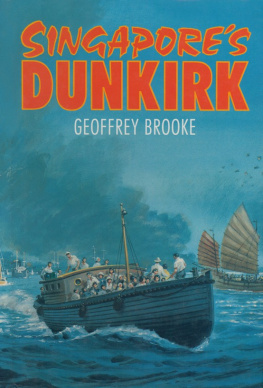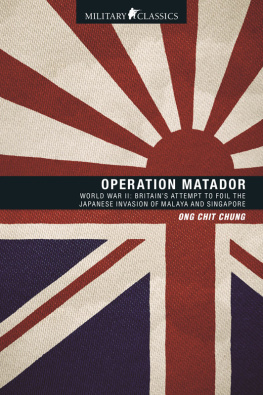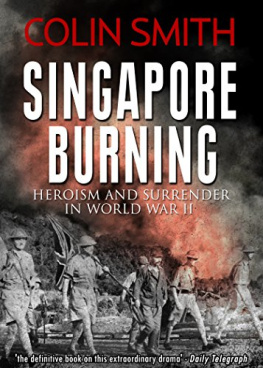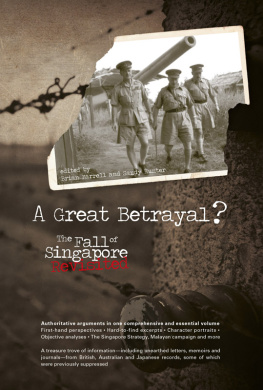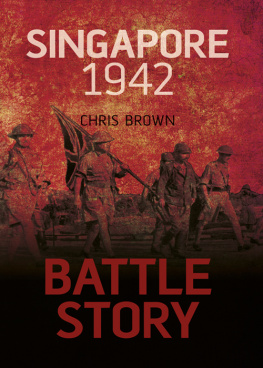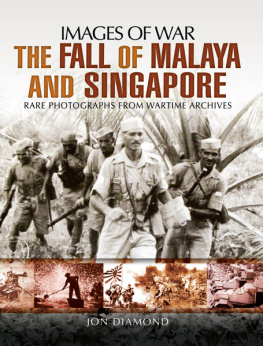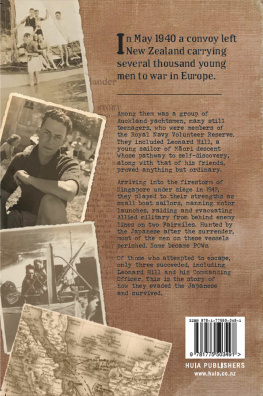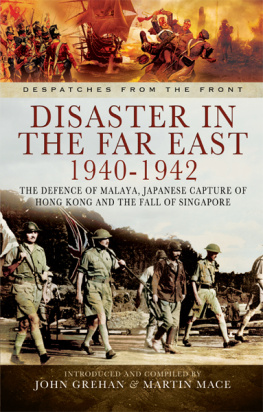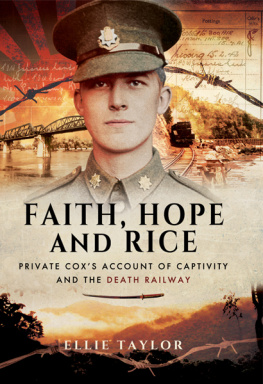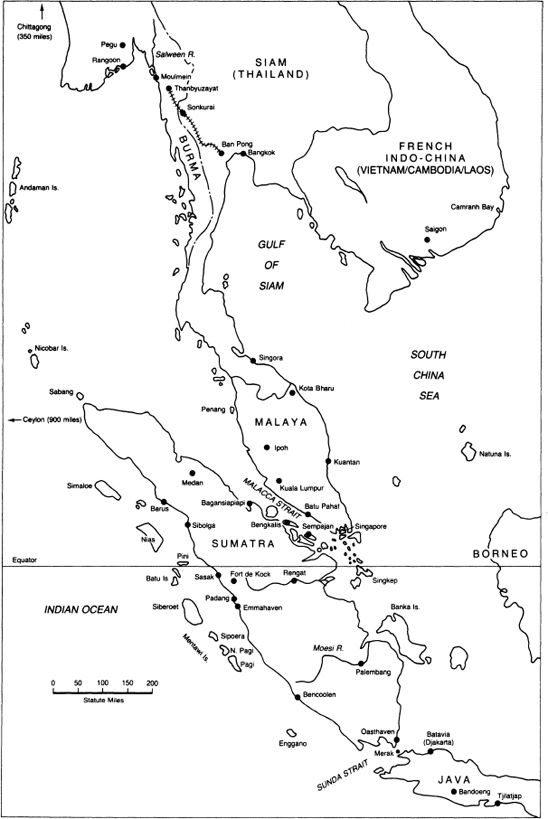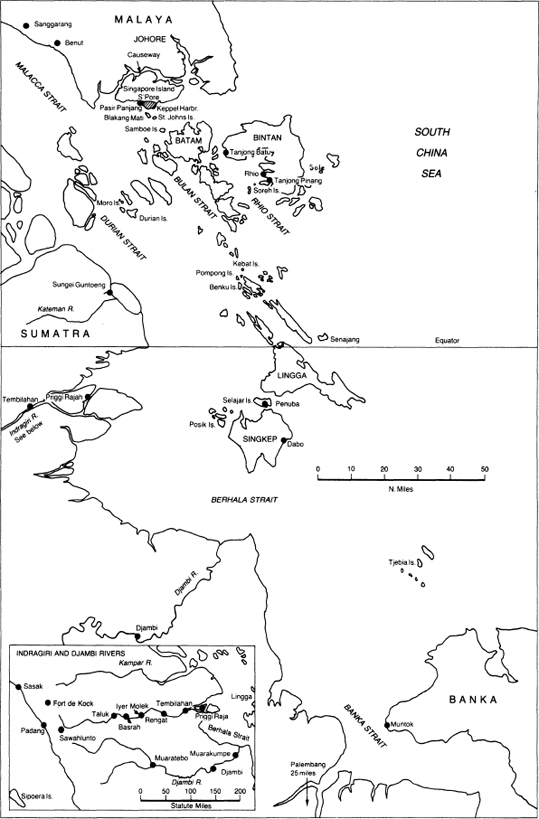Singapores Dunkirk
By the same author
Alarm Starboard!
Singapores Dunkirk
G E O F F R E Y B R O O K E
First published 1989 by Leo Cooper
Leo Cooper is an independent imprint of the
Octopus Publishing Group, Michelin House,
81 Fulham Road, London SW3 6RB
LONDON MELBOURNE AUCKLAND
Copyright Geoffrey Brooke 1989
A CIP catalogue record for this book
is available from the British Library.
ISBN 0-85052-051-7
Typeset by Hewer Text Composition Services, Edinburgh
Printed in Great Britain by
St Edmundsbury Press Ltd, Bury St Edmunds, Suffolk
and bound by Hunter & Foulis Ltd, Edinburgh
To
the late H.S.R. Cunyngham-Brown OBE
and
the late Colonel A.F. Warren CBE, DSC, RM
Contents
Illustrations
Acknowledgements
By the nature of this book I am indebted to many people for giving me permission to quote from their accounts. Sources have tended to fall under three headings: institutions, private contacts and published books.
I am most grateful to the Keeper of the Department of Documents, Imperial War Museum, Mr R.W.A. Suddaby, for effecting the introduction to Mr Leo Cooper in the first instance and for his interest and help, and that of his staff, throughout the research. The following have kindly allowed me to quote from the papers lodged by them or their antecedents at the Museum:
Mr P.G. Cazalet, Mrs M. de Malmanche, Mr R. Dykes, Mr D.P. Eastgate, Mr D. Gavin, Mrs F. Hosking (whose husband, Major F.J. Hosking, recorded a large number of exploits at the time), Mrs E. Innes-Kerr, Mrs S. Lea, Mr J. Lyon, Mr J. Marsh, Mr L. Morris, Mr R.H. Nelson, Mrs R. Ramsay-Rae, Mrs M. Reilly, Mrs X.E. Sharp (whose father, Major W.A. Barnes, also recorded many exploits at the time), Mr R. Trevor, Mrs D.E. Turner, Mrs P. Wallwork.
The Royal Commonwealth Society has kindly permitted quotations from the papers of Lieutenant H.R. Oppenheim and Mr A.P. Ross.
The following provided invaluable information personally, in some cases specially written for this book:
Mr W.B. Bevis, Mr K. Bindoff, Mrs M.R. David, Commander I.D.S. Forbes DSC, Mr R.A. Fryer, the late Mr A.W.F. Grafton, Mr W. Leah, Lieutenant-Commander E. Leather dsm, Mr W.J. Long, Mr D. Macfarlane, Colonel J.L. Nicholson OBE, Mr A.R. North, Major G. Pearse, CPO C.H. Rogers, Mr R. Tall, Mr J. Webb, Mr P. Whitworth.
My thanks are due to the following publishers or copyright holders who have kindly permitted quotations from their books, of more than the statutory number of words verbatim: Angus and Robertson (White Coolies), E. J. Burrow (Singapore to Freedom), Frances, Lady Smyth (The Will to Live), Lennard Publishing (Quiet Jungle, Angry Sea) Mr J. Larkins (A Tribute to Australian Women), Mrs J. Rivett (Behind Bamboo).
I am greatly obliged to the undermentioned for lending or providing the illustrations detailed:
Department of Photography, Imperial War Museum (Sir Shenton Thomas, a Fairmile ML), Mrs M. Allgrove (Australian Nursing Sisters); Commander J.R.H. Bull DSC (Wu Chang); Lady Cazalet (HMS Durban); the late Mr H.S.R. Cunyngham-Brown (himself); the late Mr A.W.F. Grafton (scenes of Pompong and Indragiri River); Messrs W.H. Allen (SS Rooseboom and Doris Lim); Mr B. Howard and the National Library of Australia (Miss V. Bulwinkels dress); Mr C.V. Holt (HMS Dragonfly); Mr M. Passmore (scenes onboard Sederhana Djohanis); Mr A. Stewart (Rung Wo); Mr R.D. Penhall (HMS Li Wo); Mrs E. Pidsley (Colonel A.F. Warren); Wright and Logan (HMS Stronghold).
The late Mr A.W.F. (Bob) Grafton and Mr J.C. Sharp, both of the Far Eastern Prisoners of War Association, were most helpful with contacts and references and lastly, my thanks go to Mrs F. Oddy for her dogged determination in reading my handwriting, to Mrs H. Anstruther for her withering criticism (Rephrase!), to Mr John Beatty for his helpful comments and to my wife Molly for her saintly steadiness in the face of dire domestic disruption.
Prodigious efforts to trace Mr Stewart have not been successful.
Abbreviations
| ADC | Aide-de-Camp |
| AOC | Air Officer Commanding |
| Bdr | Bombardier |
| C-in-C | Commander-in-Chief |
| CPO | Chief Petty Officer |
| FMSVF | Federated Malay States Volunteer Force |
| Gnr | Gunner |
| GOC | General Staff Officer |
| MRNVR | Malayan Royal Naval Volunteer Reserve |
| NCO | Non-Commissioned Officer |
| OR | Other Rank |
| PO | Petty Officer |
| RNR | Royal Naval Reserve |
Glossary
| atap | thatch | prauw | Malay sailing boat |
| busok | decayed | pulau | island |
| Emir | chieftain (superior to penghulu) | sampan | small Chinese sailing/rowing boat |
| juragan | skipper | Selamat jalan Bon voyage! |
| keris | dagger | serang | boat owner, boatswain |
| kampong | village | songkok | Malay velvet hat |
| kolek | canoe | taikong | skipper (Chinese) |
| nasi goreng fried rice with oddments | tongkang | motorised lighter |
| nonya | Chinese married woman | towkay | headman (Chinese) |
| pagar | paling (e.g. fishing stakes) | tuan | sir; respectful form of address |
| parang | chopper | twakow | small junk |
| penghulu | headman |
Dunkirk was a picnic compared to the eleventh hour evacuation of Singapore. The numbers were much greater at Dunkirk but there we had command of the sea, sporadic command of the air, the enemy did not press as hard as he might have, the evacuees were all fighting men and the distance to safety only forty miles.
At Singapore the enemy, almost within the gates, had complete command of the air and sea; though for the first few days succour of a sort was the same distance away, proper armed support was more like 500 miles, soon to double; but worst of all, about a third of the evacuees were civilians, including many women and children.
Much is known about Dunkirk, but many details of Singapore are obscure even now. Singapore is, of course, on the other side of the world but an equally cogent reason is the curtain that came down on information from 15 February, 1942, when it fell. Of forty-four unescorted ships of reasonable size that left, mostly on the 13th, only one or two got through. And over the five-day period from the 12 th, of about 5000 souls who were evacuated or escaped the exact number is unknown not more than one in four made it, the rest being killed or captured. Most of the survivors got to India, those in the services invariably being retained there to renew their argument with the Jap. Though a few escape stories were published during the war, the majority did not get written until the Far East Prisoners of War (FEPOWs) returned in 1945.
Next page
